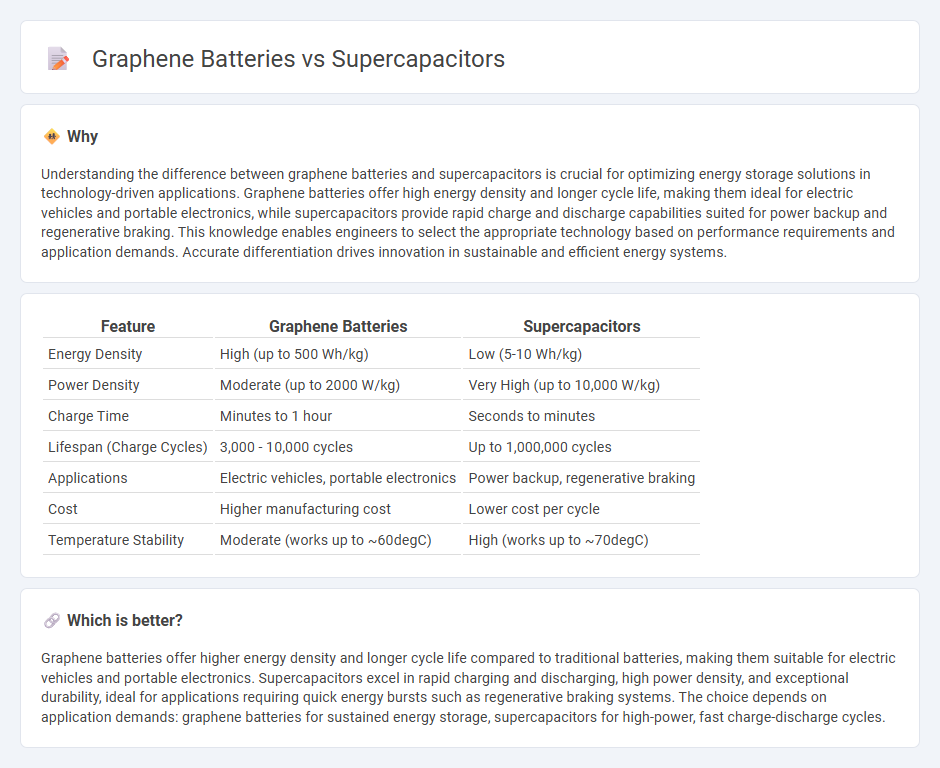
Graphene batteries leverage ultra-thin layers of carbon atoms to deliver higher energy density and faster charging times compared to conventional batteries, while supercapacitors excel in rapid energy discharge and long lifecycle stability due to their unique electrochemical properties. Key performance metrics such as charge retention, power density, and cycle durability vary significantly, making graphene batteries suitable for long-term energy storage and supercapacitors ideal for applications requiring quick bursts of power. Discover how advancements in nanomaterials are reshaping energy storage solutions by exploring the contrasts between graphene batteries and supercapacitors.
Why it is important
Understanding the difference between graphene batteries and supercapacitors is crucial for optimizing energy storage solutions in technology-driven applications. Graphene batteries offer high energy density and longer cycle life, making them ideal for electric vehicles and portable electronics, while supercapacitors provide rapid charge and discharge capabilities suited for power backup and regenerative braking. This knowledge enables engineers to select the appropriate technology based on performance requirements and application demands. Accurate differentiation drives innovation in sustainable and efficient energy systems.
Comparison Table
| Feature | Graphene Batteries | Supercapacitors |
|---|---|---|
| Energy Density | High (up to 500 Wh/kg) | Low (5-10 Wh/kg) |
| Power Density | Moderate (up to 2000 W/kg) | Very High (up to 10,000 W/kg) |
| Charge Time | Minutes to 1 hour | Seconds to minutes |
| Lifespan (Charge Cycles) | 3,000 - 10,000 cycles | Up to 1,000,000 cycles |
| Applications | Electric vehicles, portable electronics | Power backup, regenerative braking |
| Cost | Higher manufacturing cost | Lower cost per cycle |
| Temperature Stability | Moderate (works up to ~60degC) | High (works up to ~70degC) |
Which is better?
Graphene batteries offer higher energy density and longer cycle life compared to traditional batteries, making them suitable for electric vehicles and portable electronics. Supercapacitors excel in rapid charging and discharging, high power density, and exceptional durability, ideal for applications requiring quick energy bursts such as regenerative braking systems. The choice depends on application demands: graphene batteries for sustained energy storage, supercapacitors for high-power, fast charge-discharge cycles.
Connection
Graphene batteries and supercapacitors share a common foundation in graphene's exceptional electrical conductivity and high surface area, enabling rapid charge and discharge cycles. Both technologies leverage graphene's ability to enhance energy storage capacity while reducing weight and increasing longevity compared to traditional materials. Their integration paves the way for advanced hybrid energy storage systems combining high energy density with fast power delivery.
Key Terms
Energy Density
Supercapacitors offer rapid charging and high power density but have significantly lower energy density compared to graphene batteries, which combine graphene's exceptional conductivity and surface area to store more energy per unit weight. Typical supercapacitor energy density ranges from 1 to 10 Wh/kg, while graphene batteries can achieve 100 to 300 Wh/kg, bridging the gap between traditional capacitors and lithium-ion batteries. Explore further to understand how these technologies impact energy storage solutions and their applications.
Charge/Discharge Rate
Supercapacitors exhibit exceptionally high charge and discharge rates, often reaching several thousand amperes per gram, enabling rapid energy delivery and quick storage cycles. Graphene batteries, while faster than traditional lithium-ion cells due to graphene's superior conductivity, still lag behind supercapacitors in instantaneous power output and cycle speed. Explore further to understand the trade-offs between energy density and power density in these advanced energy storage technologies.
Cycle Life
Supercapacitors boast cycle lives exceeding one million charge-discharge cycles, significantly outlasting graphene batteries, which typically achieve around 5,000 to 10,000 cycles due to gradual electrode material degradation. Graphene batteries offer higher energy density and faster charging rates but sacrifice longevity when compared to the ultra-durable supercapacitors. Explore detailed comparisons of cycle life and performance metrics to determine the optimal choice for your energy storage needs.
Source and External Links
Supercapacitor - Wikipedia - A supercapacitor (or ultracapacitor) is a high-capacity capacitor storing 10 to 100 times more energy than electrolytic capacitors, bridging the gap between batteries and capacitors, used for rapid charge/discharge cycles in applications like regenerative braking and power backup.
Graphene Supercapacitors - What Are They? - Graphenea - Supercapacitors hold much more charge than standard capacitors by using porous electrodes and electrolytes instead of a solid dielectric, excelling in fast energy delivery but limited to around 5 volts per cell.
Findings from Storage Innovations 2030 Supercapacitors July 2023 - Supercapacitors have high power density, long cycle life, and high charge/discharge rates, making them suitable for grid services and short-term energy storage but less ideal for long-term energy storage due to cost and self-discharge.
 dowidth.com
dowidth.com